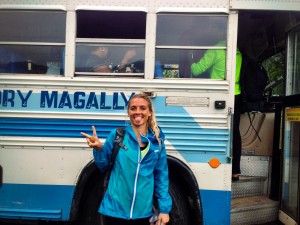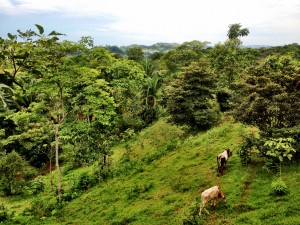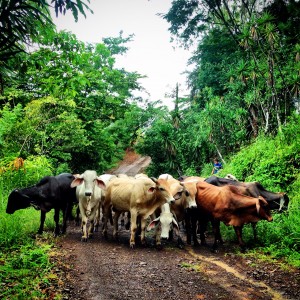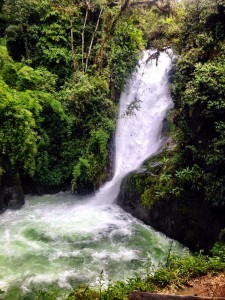I’ve spent a lot of time in Costa Rica riding the public buses. The bus system offers by far the cheapest travel options in the country, and it can get you almost anywhere you need to go.
Learning to navigate the different bus companies, find the bus stops (some marked, some not so much), and survive (more or less happily) five or six hours riding along windy, bumpy roads is all part of living here, and definitely one of its bigger challenges.
Traveling by bus though, I have been able to witness absolutely astounding beauty. I always try to snag a window seat (or take the standing room) for the trips that take you up into the mountains (which are almost all of them). As the bus heaves its way up the asphalt or rubbly rocks, you are gifted with expansive views of the countryside below. The experience for me feels breathtaking—it is amazing to watch the seemingly endless green mountains disappear behind you. You wave goodbye and see them off as they descend dramatically into gorgeous, deep valleys spotted with tiny white houses and red roofs.
This is also, I have to say, an excellent time to look at and examine landscape change (and its impacts).
There are areas of Costa Rica that remain heavily forested, thanks to gallant reforestation efforts and the creation of national parks and forest reserves. However, much of the country is not that way any longer.
Riding the bus from Rivas (a tiny town near San Isidrio) towards Dominical (at the coast), I was surprised at how developed the valleys far below me from up in the mountains looked. I have grown so accustomed to living near Santiago de Puriscal (in a tiny town located right next to La Cangreja National Park) that I found myself recoiling at the sight of so much open grassland—so many hillsides stripped bare of their trees.
The culprit in Costa Rica—the reason for much of the deforestation—is cows. Not the cows themselves per se (it doesn’t really seem fair to blame them for the loss of a country’s natural resources—after all they certainly don’t know any better), but our decision to breed and feed them. The desire to eat meat is really the major reason for loss of tree cover in this part of the world.
For over 200 years now, ranchers have been cutting down trees to provide grazing land for their cattle in Costa Rica. As more and more communities have experienced a rise in their standard of living, demand for meat has only increased—and with it the number of cows roaming the hillsides. Meat eating is seen as a sign of wealth, prestige, and even masculine power here (as in most places in the world). Unfortunately where there are cows, there has to be grass—which means fewer and fewer trees.
The hard truth is that deforestation is more than “another major environmental problem”. How we treat the worlds’ forests is very much a matter of life or death for the planet as we know it—our actions today will determine the options we have tomorrow.
Forests are not only an important sources of biodiversity and natural resources, they play major roles in our climate, the health and stability of our soils, and the functioning of our water cycles.
Deforestation is an environmental disaster that I couldn’t quite wrap my head around until coming here. It is one thing to read about the loss of the rainforest, the ecosystem services that it provides, and the species it supports…but it is another entirely to witness it first hand.
There are things that I see directly and very dramatically here, landslides being the primary one. In fact I have stumbled upon entire roads that have tumbled down the mountainside—roads that have either eroded slowly or that disappeared suddenly and dramatically in one of the rainy season’s intense deluges.
On trips to Parrita, you must walk past huge chunks of mountain that have collapsed down towards the valley. The earth smothers whatever short shaggy vegetation had been attempting to hang on with shallow roots, crushing Nature’s last stand (post tree cover). The area is marred by ugly red scars of dirt crazily crisscrossing across the land.
Not surprisingly, when it rains then, many of the rivers fill with sediment. Beautiful streams suddenly become choked with mud—something I would worry less about if it weren’t for the fact that Costa Rica uses more agrochemicals per hectare than nearly every other developing country in the world. Not only are we losing massive amounts of soil through erosion (compromising the future food supply), we’re poisoning the streams that so many people depend on as their source of drinking water.
Other impacts of deforestation feel less direct, or at least less readily apparent (albeit perhaps even more serious). Most notably, with every tree cut, our chances of slowing climate change diminish.
Clearing land for cattle grazing (something occurring at alarming rates around the entire world, not only so clearing and dramatically as in Costa Rica) contributes to climate change in two ways:
- Cows themselves directly release a surprising amount of methane into the atmosphere, a compound that (pound for pound) contributes 25 times more than carbon dioxide to climate change[i]
- Carbon is released from the decaying tree (and we lose its living ability to absorb carbon dioxide from the air)
In fact, an article by Robert Goodland and Jeff Anhang recently estimated that cattle raising could potentially contribute to up to 51% of current greenhouse gas emissions.[ii] Even the FAO has acknowledged in “Livestock’s Long Shadow” that livestock production makes up at least 18% of anthropogenic greenhouse gas emissions.[iii]
At a time when scientists are predicting that we have until 2020 to drastically cut greenhouse gas emissions, or else risk a catastrophic point of no return with regards to climate change, we need to be taking direct and immediate action—including eating less meat and replanting trees.
When we lose forests to grassland, we lose some of the world’s most incredible biodiversity as well (whatever is not already disappearing as a result of rising global temperatures).
Interested in reforestation efforts and their impact, I hiked into the Cloudbridge Nature Reserve, a small, recently restored cloud forest situated next to the primary forest of Chirripo National Park in southern Costa Rica.
The area has made a remarkable comeback. In 2002 the majority of the area that I hiked through was farmland—or more accurately grassland sustaining cows. Slowly, volunteers began replanting a variety of native species, in specific a list recommended for the area by a team of scientists including Jennifer Smith of Tierra Segura, Freddy Rojas of ITCR, and Barry Hammel of INBio.[iv]
The results of their labors have been incredible. That day, I wandered through wooded trails late into the afternoon, captivated by a forest that looked nothing short of glorious. Mist rose from the branches of tall, vibrant trees below me. Huge trunks threw themselves into the sky so thickly that it was impossible to see the ground. A huge waterfall in the distance up on the opposing hill looked dwarfed amongst the grandeur of the woods.
Jaguars, not seen for many years, have finally returned to the area, as well as spider monkeys, tapirs, and ocelots. The area hummed around me. Its creeks ran clear, even in the heavier and heavier rain that began to fall. The air felt smooth and refreshing on my face.
I felt myself come alive here.
I started back, and realized that sadly this success story is a stark cry from the area below. I was surprised to walk out from a farm gate to the sight of a lone howler monkey lurching along the country road. I had been told that no monkeys lived here—there are not enough trees for them to survive. This one had likely been kicked out of its troop, and ended up here in search of new territory, but without any sustained tree cover to facilitate its travel.
I cringed. I knew that more than likely a dog would find it soon and kill it.
I looked around. There was nothing that I could do.
When we deforest the land, we really commit an act of violence, and one that reduces the odds of our future survival on this planet.
We depend on trees for the air we breathe, for the soil from which we grow food, for storm protection, for the water that we drink, for shelter, as a home for all the other flora and fauna that we depend on and hold dear, for those that we have yet to discover even…
It’s past time to begin thinking about our policies, our dietary choices, and our daily impact on the world. We can start by examining the thing that happens (for the fortunate among us, at least) three times a day—picking up a fork. We need more ecologically-sustainable agricultural systems, and we need to eat less meat.
We need to plant trees. We must prioritize conservation.
It may be that in our fear and fight against climate change we have forgotten our most obvious weapon—our forests.
Costa Rica has stolen my heart. She is beautiful and she is wild, but I can see that with each new tumble around the sun she may becoming less so. And she is far from the only country losing the very symbol of life—our trees.
At the end of the day, we have a choice, always. What will it be?
[i] http://www3.epa.gov/climatechange/ghgemissions/gases/ch4.html
[ii] http://www.worldwatch.org/files/pdf/Livestock%20and%20Climate%20Change.pdf
[iii] http://www.fao.org/newsroom/en/News/2006/1000448/index.html







